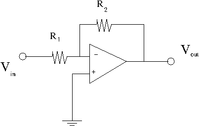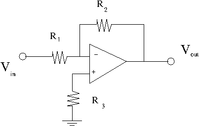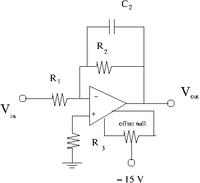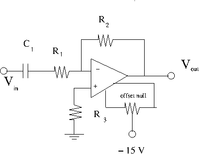Difference between revisions of "Lab 23 TF EIM"
| (35 intermediate revisions by 2 users not shown) | |||
| Line 1: | Line 1: | ||
| − | Inverting OP Amp | + | =Inverting OP Amp = |
| − | + | 1. Construct the inverting amplifier according to the wiring diagram below. | |
| − | + | ||
| + | [[File:TF_EIM_Lab23.png| 200 px]] | ||
| + | |||
| + | Here is the data sheet for the 741 Op Amp | ||
| + | |||
| + | [[File:LM741CN_OpAmp.pdf]] | ||
| + | |||
| + | |||
| + | Use <math>R_1 = 1k\Omega</math> and <math>R_2 = 10 k\Omega</math> as starting values. | ||
| + | |||
| + | 2. Insert a 0.01 <math>\mu</math>F capacitor between ground and both Op Amp power supply input pins. The Power supply connections for the Op amp are not shown in the above circuit diagram, check the data sheet. | ||
= Gain measurements= | = Gain measurements= | ||
| − | + | 1.) Measure the gain as a function of frequency between 100 Hz and 2 MHz for three values of <math>R_2</math> = 10 k<math>\Omega</math>, 100 k<math>\Omega</math>, 1M<math>\Omega</math>. Keep <math>R_1</math> at <math>1k\Omega</math>. | |
| − | + | ||
| + | 2.)Graph the above measurements with the Gain in units of decibels (dB) and with a logarithmic scale for the frequency axis. | ||
=Impedance= | =Impedance= | ||
| Line 15: | Line 26: | ||
#Measure <math>R_{out}</math> for the 10 fold and 100 fold amplifier at ~100 Hz and 10 kHz frequency. Be sure to keep the output (<math>V_{out}</math>) undistorted | #Measure <math>R_{out}</math> for the 10 fold and 100 fold amplifier at ~100 Hz and 10 kHz frequency. Be sure to keep the output (<math>V_{out}</math>) undistorted | ||
| − | = | + | = <math>V_{io}</math> and <math>I_{B}</math>= |
| + | |||
| + | ;<math>V_{out}= -\frac{R_2}{R_1} V_1 + \left ( 1 + \frac{R_2}{R_1}\right)V_{io} + R_2 I_B</math> | ||
| + | |||
| + | Use the above equation and two measurements of <math>V_{out}</math>, <math>R_1</math>, and <math>R_2</math> to extract <math>V_{io}</math> and <math>I_B</math>. | ||
| + | |||
| + | #measure <math>V_{out}</math> for <math>R_1</math> = 1 k<math>\Omega</math>, <math>R_2</math> = 100 k<math>\Omega</math>, and<math> V_{in}</math>=0 (grounded). | ||
| + | #measure <math>V_{out}</math> for <math>R_1</math> = 10 k<math>\Omega</math>, <math>R_2</math> = 1 M<math>\Omega</math>, and<math> V_{in}</math>=0 (grounded). | ||
| + | #You can now construct 2 equations with 2 unknowns <math>V_{io}</math> and <math>I_B</math>. | ||
| + | |||
| + | = <math>I_{io}</math>= | ||
| + | |||
| + | Now we will put in a pull up resistor <math>R_3= \frac{R_1 R_2}{R_1+R_2}</math> as shown below. | ||
| + | |||
| + | [[File:TF_EIM_Lab23a.png | 200 px]] | ||
| + | |||
| + | Instead of the current <math>I_B</math> we have the current <math>I_{io}</math> | ||
| + | |||
| + | ;<math>V_{out}= -\frac{R_2}{R_1} V_1 + \left ( 1 + \frac{R_2}{R_1}\right)V_{io} + R_2 I_{io}</math> | ||
| + | |||
| + | Use the same technique and resistors from the previous section to construct 2 equations and 2 unknowns and extract <math>I_{io}</math>, keep <math>V_{in}</math>=0. | ||
| + | |||
| + | = The offset Null Circuit= | ||
| + | |||
| + | [[File:TF_EIM_Lab23_b.png | 200 px]] | ||
| + | |||
| + | #Construct the offset null circuit above. | ||
| + | #Adjust the potentiometer to minimize <math>V_{out}</math> with <math>V_{in}=0</math>. | ||
| + | #Use a scope to measure the output noise. | ||
| + | |||
| + | |||
| + | =Slew rate= | ||
| + | |||
| + | Measure the slew and compare it to the factory spec. | ||
| + | |||
| + | =Power Supply Rejection Ratio= | ||
| + | #Set <math>V_{in}</math> = 0. | ||
| + | #Measure <math>\Delta V_{out}</math> while changing <math>\Delta V_{cc}</math> | ||
| + | |||
| + | =Output voltage RMS noise <math>\Delta V_{out}^{RMS}</math>= | ||
| + | |||
| + | Measure the RMS noise in <math>V_{out}</math> when <math>V_{in}</math> = 0 . | ||
| + | |||
| + | = Capacitors= | ||
| + | |||
| + | ;Revert back to the pull up resistor | ||
| + | |||
| + | ==Capacitor in parallel with <math>R_2</math>== | ||
| + | |||
| + | [[File:TF_EIM_Lab23_c.png | 200 px]] | ||
| + | |||
| + | #Select a capacitor such that<math> \frac{1}{\omega C_2} \approx R_2</math> when <math>\omega</math>= 10 kHz. | ||
| + | #Add the capacitor in parallel to <math>R_2</math> so you have the circuit shown above. | ||
| + | #Use a pulse generator to input a sinusoidal voltage <math>V_{in}</math> | ||
| + | # Measure the Gain as a function of the <math>V_{in}</math> frequency and plot it. | ||
| + | |||
| + | ==Capacitor in series with R_1== | ||
| + | |||
| + | [[File:TF_EIM_Lab23_d.png | 200 px]] | ||
| + | |||
| + | #Select a capacitor such that<math> \frac{1}{\omega C_2} \approx R_1</math> when <math>\omega</math>= 1 kHz. | ||
| + | #Add the capacitor in series to <math>R_1</math> so you have the circuit shown above. | ||
| + | #Use a pulse generator to input a sinusoidal voltage <math>V_{in}</math> | ||
| + | #Measure the Gain as a function of the <math>V_{in}</math> frequency and plot it. | ||
| + | |||
[[Forest_Electronic_Instrumentation_and_Measurement]] | [[Forest_Electronic_Instrumentation_and_Measurement]] | ||
Latest revision as of 20:48, 22 April 2011
Inverting OP Amp
1. Construct the inverting amplifier according to the wiring diagram below.
Here is the data sheet for the 741 Op Amp
Use and as starting values.
2. Insert a 0.01 F capacitor between ground and both Op Amp power supply input pins. The Power supply connections for the Op amp are not shown in the above circuit diagram, check the data sheet.
Gain measurements
1.) Measure the gain as a function of frequency between 100 Hz and 2 MHz for three values of = 10 k, 100 k, 1M. Keep at .
2.)Graph the above measurements with the Gain in units of decibels (dB) and with a logarithmic scale for the frequency axis.
Impedance
Input Impedance
- Measure for the 10 fold and 100 fold amplifier at ~100 Hz and 10 kHz frequency.
Output Impedance
- Measure for the 10 fold and 100 fold amplifier at ~100 Hz and 10 kHz frequency. Be sure to keep the output () undistorted
and
Use the above equation and two measurements of , , and to extract and .
- measure for = 1 k, = 100 k, and=0 (grounded).
- measure for = 10 k, = 1 M, and=0 (grounded).
- You can now construct 2 equations with 2 unknowns and .
Now we will put in a pull up resistor as shown below.
Instead of the current we have the current
Use the same technique and resistors from the previous section to construct 2 equations and 2 unknowns and extract , keep =0.
The offset Null Circuit
- Construct the offset null circuit above.
- Adjust the potentiometer to minimize with .
- Use a scope to measure the output noise.
Slew rate
Measure the slew and compare it to the factory spec.
Power Supply Rejection Ratio
- Set = 0.
- Measure while changing
Output voltage RMS noise
Measure the RMS noise in when = 0 .
Capacitors
- Revert back to the pull up resistor
Capacitor in parallel with
- Select a capacitor such that when = 10 kHz.
- Add the capacitor in parallel to so you have the circuit shown above.
- Use a pulse generator to input a sinusoidal voltage
- Measure the Gain as a function of the frequency and plot it.
Capacitor in series with R_1
- Select a capacitor such that when = 1 kHz.
- Add the capacitor in series to so you have the circuit shown above.
- Use a pulse generator to input a sinusoidal voltage
- Measure the Gain as a function of the frequency and plot it.




